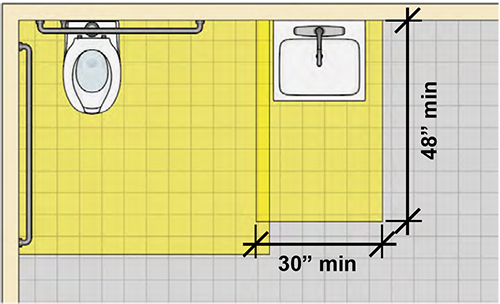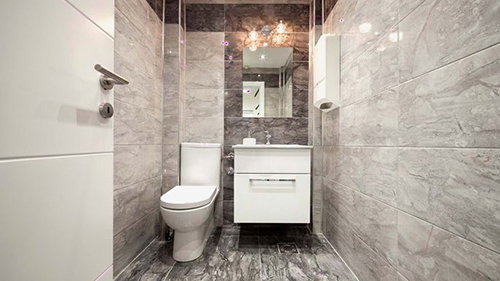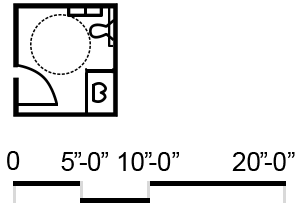Overview
Within This Page
The Private Toilet space type refers to toilets that are constructed for the exclusive use of a department, agency, or agency official. Toilets located in the following spaces are not considered Private Toilet space types: Child Care Centers, Health Clinics, Fitness Centers, Judicial Chambers, Enhanced Office (Jury Facilities), Firing Ranges, Detention, and additional toilets related to occupancy requirements in Conference Centers, Auditoriums, and Food Service Dining Areas/Cafeterias.
Space Attributes
As with other toilet/bathroom spaces, ventilation and access are the two most important issues to consider in the design of Private Toilets. In addition, careful selection of water-conserving equipment and fixtures will help reduce water consumption within the facility. Typical features of private toilet space types include the list of applicable design objectives elements as outlined below. For a complete list and definitions of the design objectives within the context of whole building design, click on the titles below.
Accessible
- While Private Toilets are permitted to be adaptable, compliance with the applicable accessibility regulations is recommended. This may include no level change thresholds, installing grab bars, faucet controls, and providing appropriate wheelchair turning space.

Single User Accessible Toilet Room Lavatory Clearance example. The lavatory cannot overlap the water closet clearance, but the clearance at the lavatory can. It is advisable (but not required) to nominally center the lavatory on the clear floor space.
Image Credit: U.S. Access Board
Aesthetics
- Materials, Flooring, Lighting, and Fixtures: Select aesthetically pleasing materials, flooring, lighting, and fixtures that are also durable, sustainable, and low maintenance.

A compact private toilet room that incorporated elegant and durable materials.
Photo Credit: Petardj/iStock
Functional / Operational
- Floor: Typically poured-in-place, reinforced concrete slab. For Private Toilets located within raised floor tenant office suites, a composite steel/concrete pedestal raised slab area is provided.
- Ventilation: Typically a 100% direct exhaust system operated by a timer or the building automation system in order to eliminate odors and facilitate quality indoor air.
- Lighting: Typically energy efficient lighting fixtures are located in the soffit above the lavatory and the toilet. Whenever possible, provide a source of natural daylighting to reduce electrical lighting loads.
- Access: Private Toilets are typically located in the proximity of the department, agency, or agency official for ease of access.
Sustainable
- Materials, Flooring, and Fixtures: Incorporate materials and fixtures that are eco-friendly, do not off-gas, and have a long life cycle.
- Water Conserving Equipment: Use water-saving fixtures such as low-flow toilets, urinals, and lavatory faucets. See WBDG Water Conservation for more information.
- Energy Use Reduction Measures: Incorporate energy-efficient lighting, fans, dryers, and other equipment such as occupancy sensors, to reduce energy use. See WBDG Optimize Energy Use for more information.
- Maintenance Practices: Incorporate sustainable maintenance practices, including reducing or eliminating the use of harsh chemicals that may affect the durability of materials or air quality.
Example Plans
The following diagram is representative of typical plans.

Private toilet space type
Example Construction Criteria
For GSA, the unit costs for private toilet space types are based on the construction quality and design features in the following table . This information is based on GSA's benchmark interpretation and could be different for other owners.
Relevant Codes and Standards
The following agencies and organizations have developed codes and standards affecting the design of private toilets. Note that the codes and standards are minimum requirements. Architects, engineers, and consultants should consider exceeding the applicable requirements whenever possible:
- Americans with Disabilities Act (ADA)
- Americans with Disabilities Act Accessibility Guidelines for Buildings and Facilities (ADAAG)
- GSA PBS-P100 Facilities Standards for the Public Buildings Service
- ICC IBC International Building Code
- ICC IgCC International Green Construction Code
Additional Resources
Publications
- Architectural Graphic Standards, 12th Edition by The American Institute of Architects, Dennis J. Hall. New York, NY: John Wiley & Sons, Inc., 2016.
- U.S. Access Board Technical Guide, Chapter 6, Toilet Rooms








